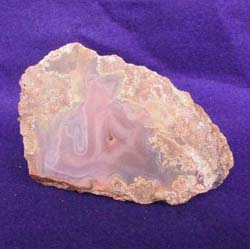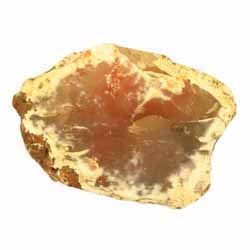Sign up for Lesson Plans, discounts & more!
Agate
Silicon Dioxide SiO2
 |
| Fire agate |
Agates are formed primarily in cavities of volcanic rock. Over time silica rich water seeping through the rock deposits minerals on the inside of these cavities. Gradually layers of silicate material build up eventually filling the cavity completely. The layers often have subtle differences in mineral content giving the agate a banded appearance.
When the cavity is only partially filled the inner layer usually shows a crystalline structure. This is often quartz, amethyst, or related mineral. This hollow rock is called a <b>geode</b>. While most often small geodes can be huge occasionally big enough to walk around in!
When the cavity completely fills the rock is no longer called a geode. It is called a thunder egg. Thunder eggs can be as varied as geodes. Oregon is famous for collecting thunder eggs.
 |
| agate, Utah |
There are many kinds of agate owing to slight changes in mineral content. These slight changes affect the color and the patterns within the rock. Descriptive and colorful names have been given to these unique varieties. Moss agate, carnelian agate, Botswana agate, blue lace agate, and Mexican crazy-lace agate are just a few of these individual types.
Because of their natural beauty agates are used to make jewelry, bookends, wind chimes, and a host of other decorative items.
Mineral Properties
Chemical formula: Silicon dioxide SiO2
Color(s): many colors and patterns
Streak: white
Luster: vitreous, glassy
Transparency: transparent to translucent
Crystal system: triagonal
Specific Gravity: 2.6
Hardness (Mohs): 7
Cleavage: none
Fracture: conchoidal
Uses: jewelry, bookends, wind chimes, and other decorative items.
Location: widespread occurance

INTERESTED IN MORE? IF SO, YOU MAY WANT TO CHECK OUT OUR OTHER SITES:
fossilicious.com - Our online fossil and mineral rock shop.
fossils-facts-and-finds.com - An educational site about fossils.











